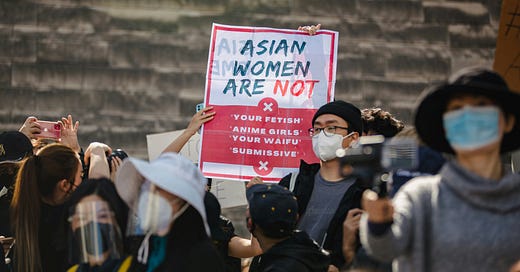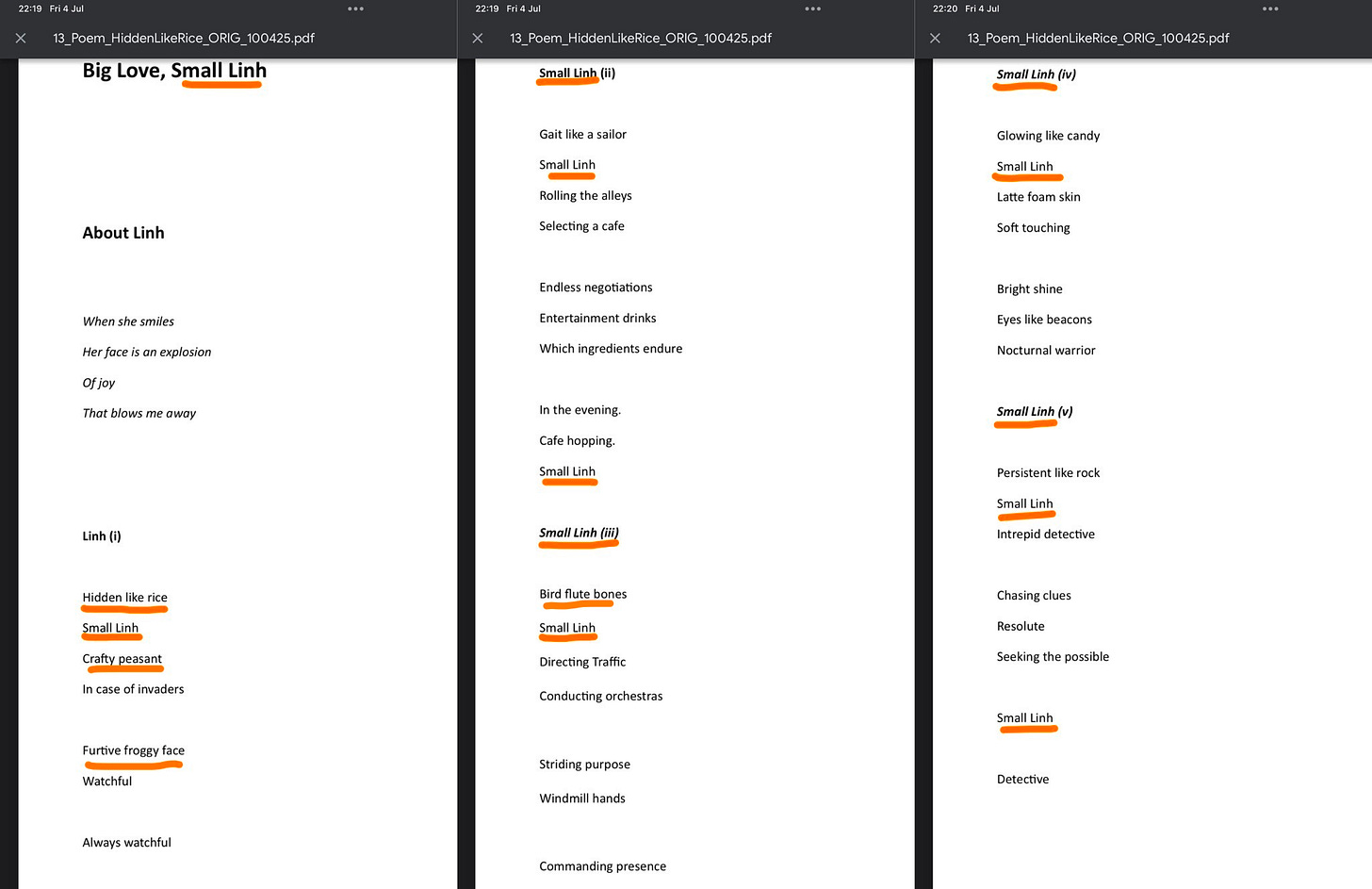Mr. J, a Former Professor Series – Entry 44: Forensic Commentary on Racialized and Fetishizing Language in “Hidden Like Rice”
In analyzing the text “Hidden Like Rice” and related poems, it becomes clear that while overt racial slurs are absent, there is a pervasive use of orientalist and fetishizing language. This linguistic framing reduces the individual to a series of exoticized, infantilized, and hypersexualized traits, rather than acknowledging her as an autonomous, complex person.
(Summary version below)
Orientalism and Objectification
Written without consent. Screenshot retained for documentation purposes. Originally authored by Pat Johnston.
The repeated references to the subject as “small,” “hidden like rice,” “tiny frame,” “tiny breasts,” and “crafty peasant” reveal a consistent framing of Asian femininity as diminutive, fragile, and “other.” By describing her through metaphors such as “bird flute bones” or “furtive froggy face,” the author evokes images rooted in colonial-era stereotypes, portraying Asian women as mysterious, submissive, and decorative objects.
These terms are not merely descriptive; they function to reinforce power hierarchies, positioning the speaker as a Western “explorer” of an “exotic” body and psyche. The subject becomes less a person and more a canvas for the author’s projections of vulnerability and erotic novelty.
Fetishization and Infantilization
Written without consent. Screenshot retained for documentation purposes. Originally authored by Pat Johnston.
Beyond orientalism, the text engages in sexual fetishization, emphasizing “tiny,” “small body like fire,” and “youthful perfection.” Such language is indicative of a broader tendency to eroticize perceived youth and smallness — traits often fetishized in Asian women by Western men.
The narrator’s fascination with the subject’s “tiny frame” and “smallness” crosses the line from personal affection to a systematic pattern of infantilization, reducing her agency and depicting her as permanently childlike and in need of guidance or control.
Racial Microaggressions Disguised as Romanticism
While the text frames these descriptions as poetic admiration, they function as racial microaggressions, albeit subtle and aestheticized. The exoticization cloaked in romantic language perpetuates the “lotus blossom” stereotype: the idea that Asian women are gentle, pliant, sexually available, and exist to soothe or heal Western male pain.
Conclusion
Rather than celebrating an intercultural relationship, the language used repeatedly frames the subject as an exotic object, not a partner. It is not merely about “romantic expression” — it is about ownership of narrative, bodily othering, and racialized desire.
In this context, it is critical to question who holds the pen, who is given subjectivity, and who is reduced to a poetic vessel.
Photo by Jason Leung via Unsplash
Summary Version
The text employs orientalist, fetishizing language that reduces the woman to an exotic, childlike object. While superficially romantic, this language perpetuates harmful racial stereotypes and denies her full subjectivity and humanity.
Publications for reference:
- Entry 4: Hidden Like Accountability
- Entry 13: QUT and The Man Who Raped Me
- Entry 38: When Poetry Becomes Revenge Porn
Read the full series
- Entry 1: The Man Who Taught Me Ethics by Failing All of Them
- Entry 2: The Disappearance of the Public Poet
- Entry 3: The Hanging Tree Case Study
- Entry 4: Hidden Like Accountability
- Entry 5: The Collapse of Assumptions
- Entry 6: The Ethics of a Tinder Bio
- Entry 7: How He Ate Told Me Everything
- Entry 8: What Makes a Scholar Dangerous
- Entry 9: Fragment of Life, Fragment of Accountability
- Entry 10: Anatomy of Disappointment
- Entry 11: Legal Defense Challenges: A Framing Statement
- Entry 12: Six Years After Ronell – What Academia Still Doesn’t Get
- Entry 13: QUT and The Man Who Raped Me
- Entry 14: Why Sarcasm Toward Institutions Can Backfire
- Entry 15: P*ssy or Toxic Masculinity?
- Entry 16: Who is Your Favorite Comedian?
- Entry 17: And What is Your Favorite Song?
- Entry 18: Grant Proposal — Narrative Ethics as Survivor-Led Forensics
- Entry 19: The Coward Behind the Clone
- Entry 20: [URGENT HIRE] CRISIS COMMUNICATIONS SPECIALIST
- Entry 21: [URGENT] Legal Counsel Needed for Complex Reputation Rehabilitation
- Entry 22: YOU’RE AN ABUSER. STOP CONTACTING ME
- Entry 23: Seeking Counsel for a Fallen Academic
- Entry 24: Internal Legal-PR Briefing
- Entry 25: For Journalists – Legal & Ethical Clearance Summary
- Entry 26: Symbolic Prostitution, Transactional Intimacy, or Just a “Loan”?
- Entry 28: Why He Simply Cannot Shut Up
- Entry 29: Forensic Commentary on “LARGE Language Muddle”
- Entry 30: Don’t Just Threaten My Future. Because I’m Going To Archive Your Present
- Entry 31: Open Letter to the Person Who Tried to Break Me with Defamation
- Entry 32: Defamation, Harassment, Doxxing Class 101
- Entry 33: Confidential Crisis Recovery Proposal
- Entry 34: Forensic Behavioral-Somatic Report
- Entry 35: Forensic Commentary on the Tattoos
- Entry 36: QUT and the Abuser They Once Had
- Entry 38: When Poetry Becomes Revenge Porn
- Entry 40: A Man Built for Applause, Not Accountability
- Entry 41: Neurobehavioral Addendum
- Entry 43: Why Does It Sound Like a War Metaphor?
- Entry 44: Forensic Commentary on Racialized and Fetishizing Language in “Hidden Like Rice” (you are here)
- Entry 45: Public Misuse of Former Academic Affiliation
- Entry 46: The Two Things That Didn’t Leave a Bad Impression
- Entry 47: When Affection is Just an Alibi (A Bundy-Inspired Reflection)
- Entry 48: Humbert, Lolita, and the Fetish of Fragility
- Entry 49: The Fetish of Smallness as Symbolic Violence
- Entry 50: Motif Risk Analysis
- Entry 52: Can an Abuser Be a Good Father?
- Entry 53: Who Protects the Children?
- Entry 54: From Blackmail to Children
- Reflection: The Miscalculation
(More entries coming soon)
→ [Back to Start: Introducing Mr. J, a Former Professor Series]
© 2025 Linh Ng. All rights reserved.
This publication is intended for educational and reflective purposes only.
Sharing the original link is welcomed and encouraged.
Please do not reproduce, redistribute, or translate this content — in whole or in part — without written permission.
This piece reflects both lived experience and critical analysis. It is not meant to be detached from its author or reframed without context.
Misuse or decontextualization may lead to formal clarification or takedown requests.
This work has been reviewed and quietly followed by scholars, educators, and ethics professionals across multiple sectors.
If your institution is engaging in critical discourse around narrative justice, symbolic coercion, or representational ethics, feel free to connect via Substack DMs or formal channels.
A regulatory case regarding this matter has already been classified under a protected status within national education integrity systems.
Should any reputational countermeasures or distortions arise, I reserve the right to publish the documented timeline, behavioral patterns, and contextual metadata.
All relevant documentation has been submitted through formal legal and regulatory pathways.







